Aug 21 2010
PI has provided world class solutions for industry, OEM and research for several decades. PI (Physik Instrumente) L.P., is the U.S. operation of Physik Instrumente (PI) GmbH & Co. KG.
The PI family of companies employs more than 350 people world wide. PI is known throughout the high-tech world for its leadership in the design and manufacture of Nanometer-Level Motion Control Products, Piezo Ceramics and NanoActuators, Hexapod 6DOF Positioning Systems and Micro Robots.
PInano™ 1x3 XYZ & XY Piezo Stage Systems
Low-Profile, Low-Cost, Nanopositioning Systems for Super-Resolution Microscopy
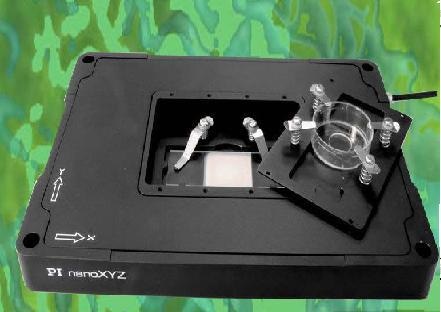
Figure 1. PInano™ series nanopositioning stages feature a very low profile of 20 mm (0.8”), a large aperture for 1x3" slides and deliver highly accurate motion with sub-nanometer resolution in up to 3 axes. Slide / petri dish holders optional.
Some key aspects of the device are:
- Low Profile for Easy Integration: 20 mm (0.8“)
- Large Aperture for 1x3"Slides. Accessories & Holders Available
- All Parts Black Anodized for Minimum Reflections
- 200ìm Standard Travel Range, Longer Ranges Available
- Longest Lifetime with Proprietary PICMA® Piezo Technology
- Cost Effective due to Low-Cost Piezoresistive Sensors
- Compatible w/ Leading Image Acquisition Software Packages
- Closed-Loop Control for High Repeatability and Accuracy
- Millisecond Step Time, ideal for Super-Resolution Microscopy
- Recessed Sample Holders for Maximized Utility
Long Travel, Low Profile, Optimized for Microscopy
The new PInano™ XY and PInano™ XYZ low-profile piezo scanning stages are optimized for easy integration into high resolution microscopes. They feature a very low profile of 0.8“ (20 mm), a large aperture, and long travel ranges of up to 200 x 200 x 200 ìm with subnanometer closed-loop resolution – ideal for leading-edge microscopy and imaging applications.
Longest lifetime is guaranteed by the integrated ceramicencapsulated PICMA® piezo actuators. Due to the significantly higher humidity resistance, the patented PICMA® design provides up to 10 times longer life than conventional piezo actuators.
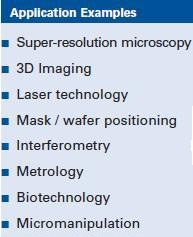
Cost Effective Design, High Performance
PInano™ series piezo positioning stages are designed to provide high performance at minimum cost. For highly stable, closed loop operation, piezoresistive sensors are applied directly to the moving structure and precisely measure the displacement of the stage platform.
The very high sensitivity of these sensors provides optimum position stability and responsiveness as well as sub-nanometer resolution. A proprietary servo controller significantly improves the motion linearity compared to conventional piezoresistive sensor controllers.
Working Principle / Reliability
Flexures optimized with Finite Element Analysis (FEA) are employed to guide the PInano™ series stages. FEA techniques give the design the highest possible stiffness in, and perpendicular to, the direction of motion, and to minimize linear and angular runout. Flexures allow extremely high-precision motion, no matter how minute, as they are completely free of play and friction.
The award-winning PICMA® piezo drives are more robust than conventional piezo actuators, featuring superior lifetime and performance in both dynamic and static applications. Because guidance, actuators and sensors are all maintenance-free, these nanopositioning systems achieve outstanding levels of reliability.

Figure 2. Background: The piezo controller is included and comes with a 24-bit resolution USB port as well as ethernet, RS-232 and an analog interface.
Foreground: The optional M-545 manual XY stage provides a stable platform for the the PInano™ piezo stage. R2 piezo stage versions (60x60 mm aperture) shown.
| Model |
PInano XY |
PInano XYZ |
Units |
Tolerance |
| Active axes |
X, Y |
X, Y, Z |
|
|
| Motion and positioning |
| Integrated sensor |
Piezoresistive |
Piezoresistive |
|
|
| Closed-loop travel |
200 x 200 |
200 x 200 x 200 |
ìm |
|
| *Resolution |
<1 |
<1 |
nm |
typ. |
| Linearity |
+/- 0.1 |
+/- 0.1 |
% |
typ. |
| Repeatability |
<5 |
<5 |
nm |
typ. |
| Mechanical properties |
| Push/pull force capacity in motion direction |
100 / 30 |
100 / 30 |
N |
Max. |
| Max. payload |
500 |
500 |
g |
Max. |
| Drive properties |
| Ceramic type |
PICMA® P-885 |
PICMA® P-885 |
|
|
| Electrical capacitance per axis |
6 |
6 (X, Y), 12 (Z) |
ìF |
±20% |
| Miscellaneous |
| Recommended operating temperature range |
20 to 30 |
20 to 30 |
°C |
|
| Material |
Aluminum |
Aluminum |
|
|
| Mass |
1 |
1.2 |
kg |
±5% |
| Cable length |
1.7 |
1.7 |
m |
±10 mm |
| Sensor / voltage connection |
Sub-D 25 |
Sub-D 25 |
ìF |
±20% |
*Resolution of PI Piezo Nanopositioners is not limited by friction or stiction. Value given is noise equivalent motion measured with interferometer.
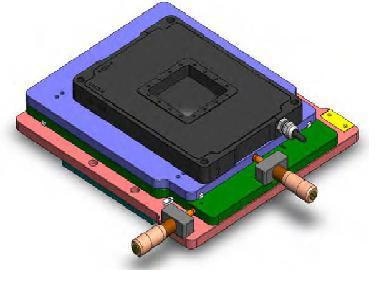
Figure 3. The P- 545 piezo stage can be mounted on the optional M-545 manual XY stage. This high-stability stage is recommended as a basis for the piezo stage, especially when the highest step-and settle performance is required. It is available for Olympus, Nikon, Zeiss and Leica microscopes and can also be upgraded with motorized micrometers.

P545.xR7 Mounting
P-545 Stages have two mounting surfaces. The primary surface is on the top of the stage and protrudes from 0.5 mm from the body of the stage.
A secondary mounting surface is provided on the bottom of the stage. This surface allows mounting closer to the bottom surface of the stage body which can be useful in some applications, such as microscopy.
The planar dimensions and mounting hole pattern are identical.
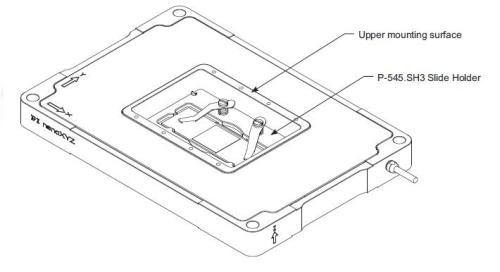
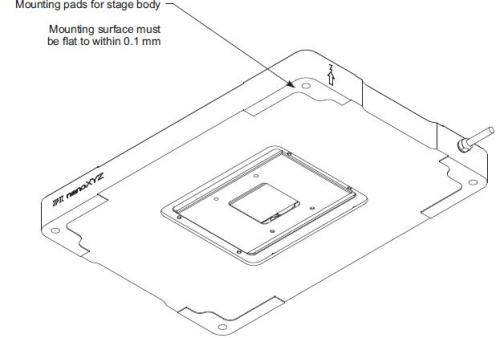
Optional High-Stability Manual Microscope Stage as Basis for Piezo Stage
PI has designed the P-545 stage to be easily integrated to commercial microscopes through the use of the M-545 stage. M-545 stages are available for Nikon, Olympus, Zeiss and Leica inverted microscopes. These stages mount directly to the microscope base and accept the P-545.3R and P-545.2R as well as several other PI stages. The M-545 stages can be manually driven through micrometers or using PI’s precision motorized actuators. Contact your PI sales representative for details.
When used in a microscope application, the focal plane for the microscope is located near the bottom of the stage. It is for this reason that the stage has a lower mounting surface. The figure below shows the nominal location of the focal plane. Vertical travel of the objective varies based on the microscope used.
A series of accessories is available from PI to assist with mounting a sample holder to the stage. The P-545.SH1 is available to hold standard 1”x 3” (25mm x 75mm) microscope slides and the P-545.PD1 is offered for holding 35mm Petri Dishes.
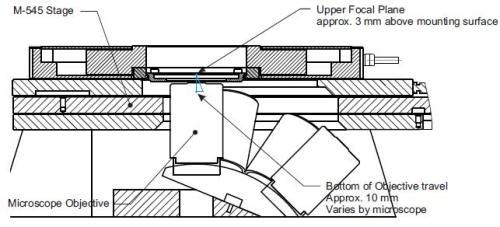
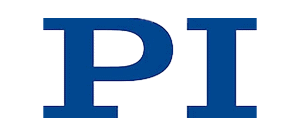
This information has been sourced, reviewed and adapted from materials provided by PI (Physik Instrumente) LP, Piezo Nano Positioning.
For more information on this source, please visit PI (Physik Instrumente) LP, Piezo Nano Positioning.